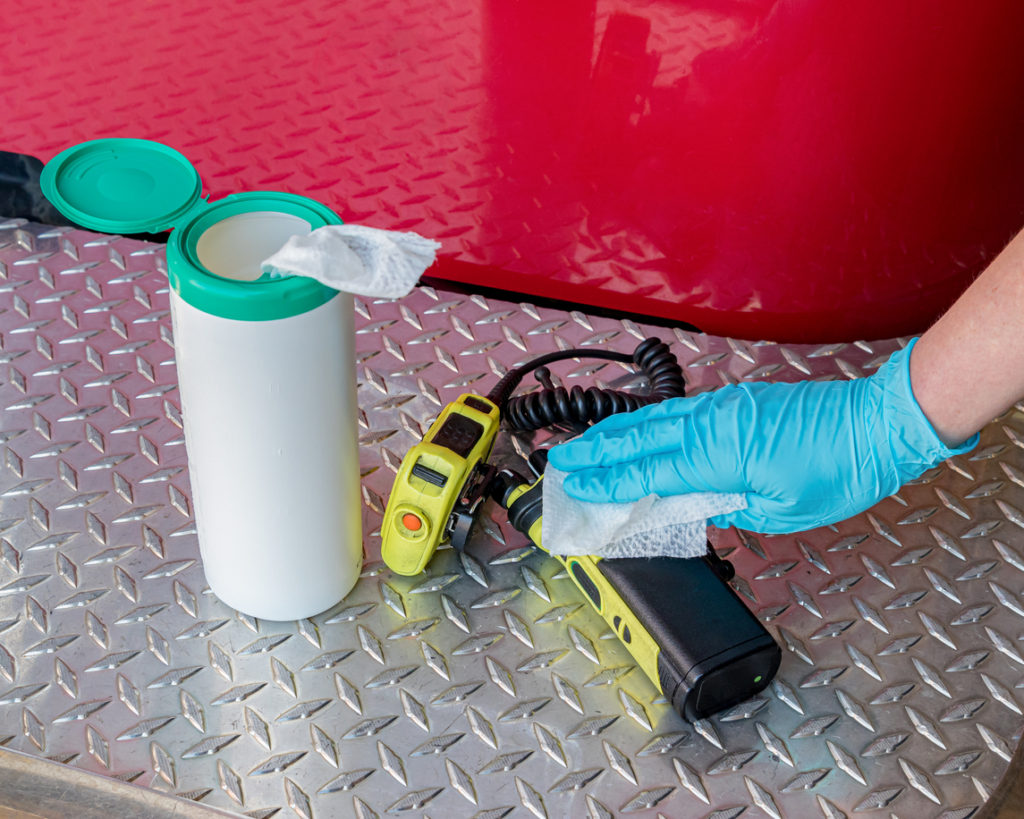

The novel Coronavirus has brought pain and heartache to millions of families, including many in our own firefighting communities. A quick Google search reveals hundreds of local obituaries of veteran first responders who have succumbed to the disease – all leaving behind distraught families to pick up the pieces.
Fortunately, over the past several months, our learning about virus safety and protection has grown by leaps and bounds. Prominent epidemiologists, infectious-disease specialists and public health experts have quickly educated us about simple and effective steps we can all take to avoid contamination, including frequent handwashing and sanitation, social distancing and mask wearing.
For first responders, of course, the risk of contamination is part of the job, but that doesn’t mean your department can’t be protected against COVID-19. We have compiled some recommendations for COVID safety across three main areas of potential exposure: personal protective equipment, fire apparatus and fire stations.
Personal Protective Equipment (PPE)
When it comes to PPE, a whole new level of protection is indicated compared to firefighters’ normal routines. The right type of protective clothing can limit the transmission of the infectious aerosols and liquids that can contaminate skin and clothing. Clothing and gloves should provide protection against viral penetration according to NFPA standards and should be laundered daily with bleach or dry cleaned.
Respirators effective against COVID-19 should replace common surgical masks or dust masks. The minimum requirement for facial protection is an N95 filtering facepiece respirator that meets the filtration efficiency and other requirements approved by the National Institute for Occupational Safety and Health (NIOSH). Even better, is a NIOSH-approved P100 filtering facepiece, which takes filtration efficiency to near 100 percent. Double-gloving is recommended for hand protection, especially in high-risk situations involving excessive liquids.
Once your department is properly equipped, be sure everyone is well-versed in how to wear each PPE item, following manufacturer instructions. When in the field, all personnel must avoid touching the nose, mouth, eyes or face generally, especially after coming into contact with contaminated surfaces. PPE donning and doffing procedures should follow guidelines from the Centers for Disease Control (CDC), World Health Organization (WHO) and other qualified organizations.
Fire Apparatus
COVID-19 has forced departments to elevate their cleaning protocols to a new level. It’s important to emphasize that while cleaning removes germs, dirt and impurities from surfaces, only disinfection actually kills germs and eliminates contamination. All surfaces should be routinely cleaned and then disinfected with an EPA-registered disinfection (as listed on the EPA website). Best results can be achieved by using an electrostactic sprayer to apply the disinfectant to ensure complete coverage. Fully conforming personal protective equipment should be worn by all personnel involved in cleaning and sanitation. Be sure to pay special attention to high-touch areas, including seat belts, door handles, grab handles, steering wheel, arm rests and controls.
Fire Stations
While best practices always include regular cleaning around the fire station, it is especially important in the struggle against COVID-19. Disinfection procedures now need to become a regular part of the cleaning routine in addition to all standard “regular” cleanings. Once procedures have been developed and implemented, it’s important to document day-to-day schedules with specific assignment of responsibilities and accountability. For example, administrative personnel and other staff should be expected to clean and disinfect their own personal office space and work surfaces daily.
Sharing of communal items like towels and utensils should be minimized. Hand sanitizing stations should be added around all entry points, especially between apparatus bays and living quarters. Contaminated items of clothing and shoes should be removed prior to entering the living quarters. Finally, the number of civilians entering all living spaces should be minimized.
Bathrooms deserve special mention, because sanitation should be paramount. Regular sanitation should occur at least daily and users should be encouraged to wipe down sinks and faucets with each use. Here’s where explicit tracking of cleaning personnel and times and dates cleaned could be useful.
Education is Paramount
We all have had to learn to keep ourselves safe during this uncertain time—and firefighters especially have to understand the latest scientific findings about the disease. Yet taking precautions against COVID-19 need not be a burdensome task that demoralizes staff and slows down efficiency. By becoming well-versed in the new requirements in combating the disease and educating staff thoroughly, taking precautions can become second nature. There are a multitude of resources out there to use as reference guides in keeping your departments safe, including the National Fire Protection Agency, ASTM International, the World Health Organization and the Centers for Disease Control. Once you have developed standards and procedures that work for your department, be sure to keep up the vigilance and keep everyone safely on board.
